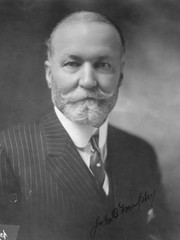This article is part of the series "A Moment in History" where we honor those who have contributed to the growth of medical knowledge in the areas of anatomy, medicine, surgery, and medical research.

John Benjamin Murphy
Dr. John Benjamin Murphy (1857 – 1916). An American surgeon, John Benjamin Murphy was born in Appleton, Wisconsin in 1857. He studied anatomy and physiology in Appleton under the care of Dr. H.W. Reilly, a local physician, after which J.B. Murphy entered the Rush Medical College, receiving his degree in 1879.
Urged by the new trends in surgery and antisepsis, in 1882 Dr. Murphy he traveled to Vienna to study with Theodor Billroth (1829 – 1894), and then on to Heidelberg and Berlin. Upon his return, he started great advances in the surgery of the time. One of them was to propose the immediate extirpation of the vermiform appendix when acute appendicitis was diagnosed, as opposed to the common practice of waiting until the vermiform appendix ruptured.
In 1892 Dr. Murphy became professor of clinical surgery at the College of Physicians and Surgeons in Chicago. Dr. Murphy is one of the founders of the American College of Surgeons. His surgical endeavors span many specialties including abdominal, thoracic, peripheral vascular, orthopedics, neurosurgery, etc.
One of his well-known inventions was a metal sutureless compression anastomotic device, known to many as the “Murphy button”. Although in 1826 Denans and Henroz had created metal compression anastomotic devices with a similar concept, Murphy’s improvements on the device caused it to be used well into the 1900’s. The reason for this is the support the device had from the Mayo brothers, founders of the today well-known Mayo Clinic. Although not a stapler, the Murphy button established the need for anastomotic leakage control and the possibility of and end-to-end anastomosis. This makes Dr. Murphy's concept part of the history of surgical stapling. For an image of the Murphy anastomotic device click here, the link is courtesy of the Museum of Health Care at Kingston, Canada.
Murphy’s first use for his device was for a cholecystojejunostomy, the anastomosis of the gallbladder to the jejunum to allow drainage of the bile into the digestive system.
His name is remembered in many eponyms: Murphy’s button, Murphy’s drip, Murphy’s test, Murphy’s punch, and the Murphy-Lane bone skid.
Sources:
1. “Cholecystointestinal, gastrointestinal, enterintestinal anastomosis, and approximation without sutures” Murphy JB. Med Rec (1892) 42: 665
2 . “John Benjamin Murphy – Pioneer of gastrointestinal anastomosis” Bhattacharya, K., & Bhattacharya, N. (2008). Indian J. Surg., 70, 330-333.
3. “The Story of Surgery” Graham, H. (1939) New York: Doubleday, Doran & Co.. Inc.
4. “Compression Anastomosis: History and Clinical Considerations”Kaidar-Person, O, et al, e. (2008) Am J Surg, 818-826.
5. “Current Practice of Surgical Stapling” Ravitch, M. M., Steichen, F. M., & Welter, R. (1991) Philadelphia: Lea& Febiger.
6. “Rese¤as Históricas: John Benjamin Murphy” Parquet, R.A. Acta Gastroenterol Latinoam 2010;40:97
Image in the public domain. National Library of Medicine